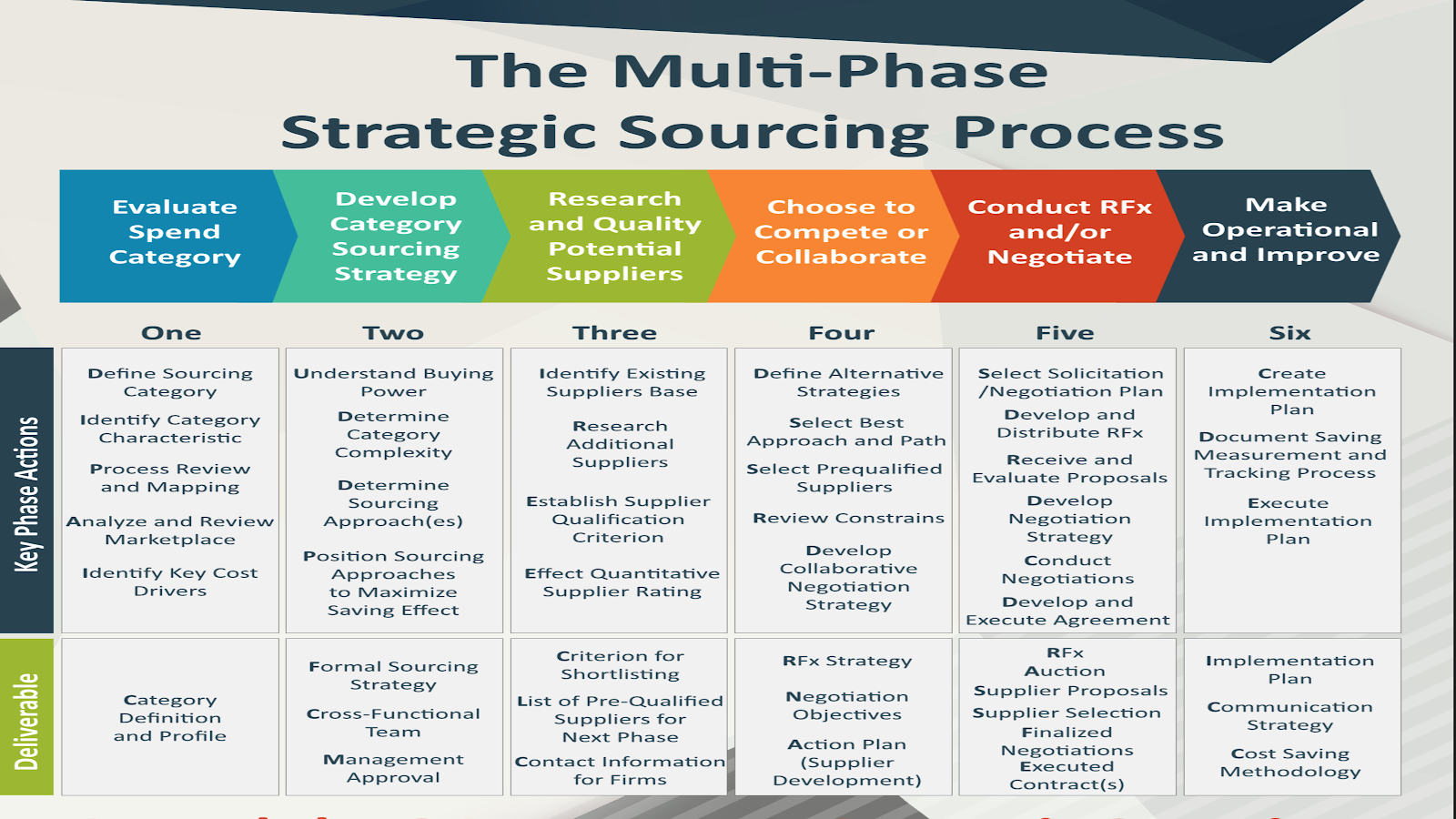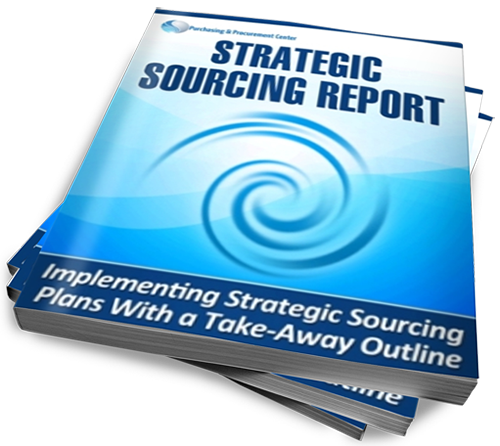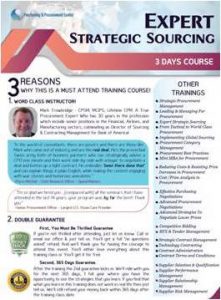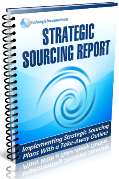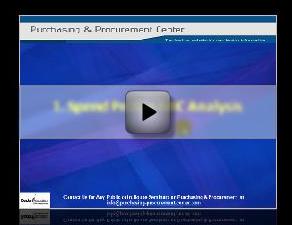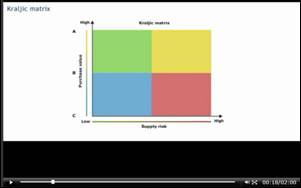The 7 Step Strategic Sourcing Process!
Strategic Sourcing Process Like You’ve Never Seen & Read Before!
Yes, it’s probably a bold claim but as you go through below, you’ll soon find out that this is likely the only place where you will know all about strategic sourcing process.
Combined with short, less than 2 minutes scenario-based e-learning to illustrate each step and principle with real-life scenarios, you will have a fulfilling feeling that you’ve learned more about strategic sourcing here and today, than you ever learned and knew from many other blogs and resources you might have read previously.
But let’s start with the Big Picture First ….
What is Strategic Sourcing Definition?
It helps to understand strategic sourcing as part of the bigger procurement process picture, since sourcing occupies what we call the “upstream procurement process” vs downstream.
You can visualize the procurement processes for recurrent purchases as a figure eight with two closed loops, one is an upstream loop, and the other one, a downstream loop.
Essentially this upstream process that is also called strategic sourcing process, deals with what happens BEFORE you award the contract for goods or services. It groups all the tasks you must execute before signing the contract.
This is also the formal Strategic Sourcing Process that Includes 7 Steps:
The 7 Steps Strategic Sourcing Process Summary:
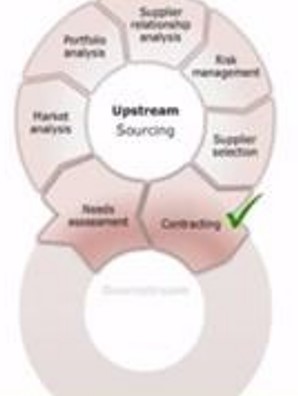
- Needs Assessment
- Market Analysis
- Portfolio Analysis
- Supplier Relationship Analysis
- Risk Management
- Negotiate & Select Supplier
- Continuous Improvement.
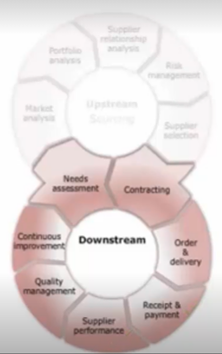
On the other hand, the downstream activities include all steps that must be completed in order to make sure goods are ordered and delivered in line with the contractual agreements.
Order fulfillment, invoice payment, and the supplier performance measurement, are part of the downstream loop. The downstream process itself is also called operational procurement.
The circular patterns of the two procurement loops show that the procurement processes are continuous. The downstream activities will provide input for the upstream activities and vice versa.
Watch the short scenario-based e-learning below that gives a summary of the full upstream or Strategic Sourcing Process:
The 7 Step Strategic Sourcing Process in Full!
Now that the big picture of strategic sourcing is clear with all its steps, let’s look at each of the 7 steps of strategic sourcing process in detail.
Step 1 – Needs Analysis!
It is one of the biggest challenges for procurement teams to get a clear picture of the products or services needed by the internal customers. Especially, since internal customers are spread throughout the complete value chain.
For many organizations, it is even a bigger challenge to engage internal customers to involve a professional buyer within the supply selection process.
It is a common scenario where internal-customers/end-users do not want to involve the procurement department. They might just sign the contract which might not have the best terms, resulting in after-delivery problems, increase in costs and most important it creates compliance issues.
The key is for procurement to identify the needs of the organization by implementing systems, procedures, processes, and most of all, by creating a sound relationship with the internal customers.
This last piece ...
"creating a sound relationship with the internal customers, helps to avoid conflict, increases compliance and significantly reduces total cost."
Watch this first-step of strategic sourcing process 'in action' below:
Step 2 – Market Analysis!
Market analysis refers to the collection and analysis of supply market data. This data can be collected from reports and published statistics. You can also get additional information from the internet by asking other suppliers, visiting trade fairs, asking advice from experts, and so on.
Why perform the market analysis step?
The aim of supply market analysis is to gain insight into the investments to be made, into the risks involved, and into the capabilities of the potential suppliers.
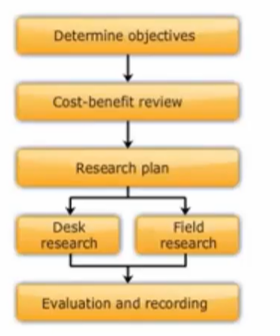
How to perform market analysis?
Market analysis is achieved by executing five tasks.
First, the objectives are determined.
Second, the cost versus benefit is reviewed.
The third task is the creation of the research plan.
During the fourth task, the desk and field research is executed.
The final task is the evaluation and recording of the obtained data and results.
Watch the scenario-based e-learning below with a real-life interaction between the Buyer and the Procurement Director to understand how market analysis happens.
Step 3 – Portfolio Analysis!
While there are different tools to do portfolio analysis, one of the buyers’ most commonly used portfolio analysis tool is Kraljic Matrix.
What is Kraljic Matrix?
Kraljic matrix is a method used to segment the purchases or suppliers by dividing them into four quadrants, based on the complexity or risk of the supply market and the purchase value of the items/goods purchased.
Essentially the more you spend with one supplier the more important they are vs the risk of finding and securing the items/goods/suppliers in the marketplace.
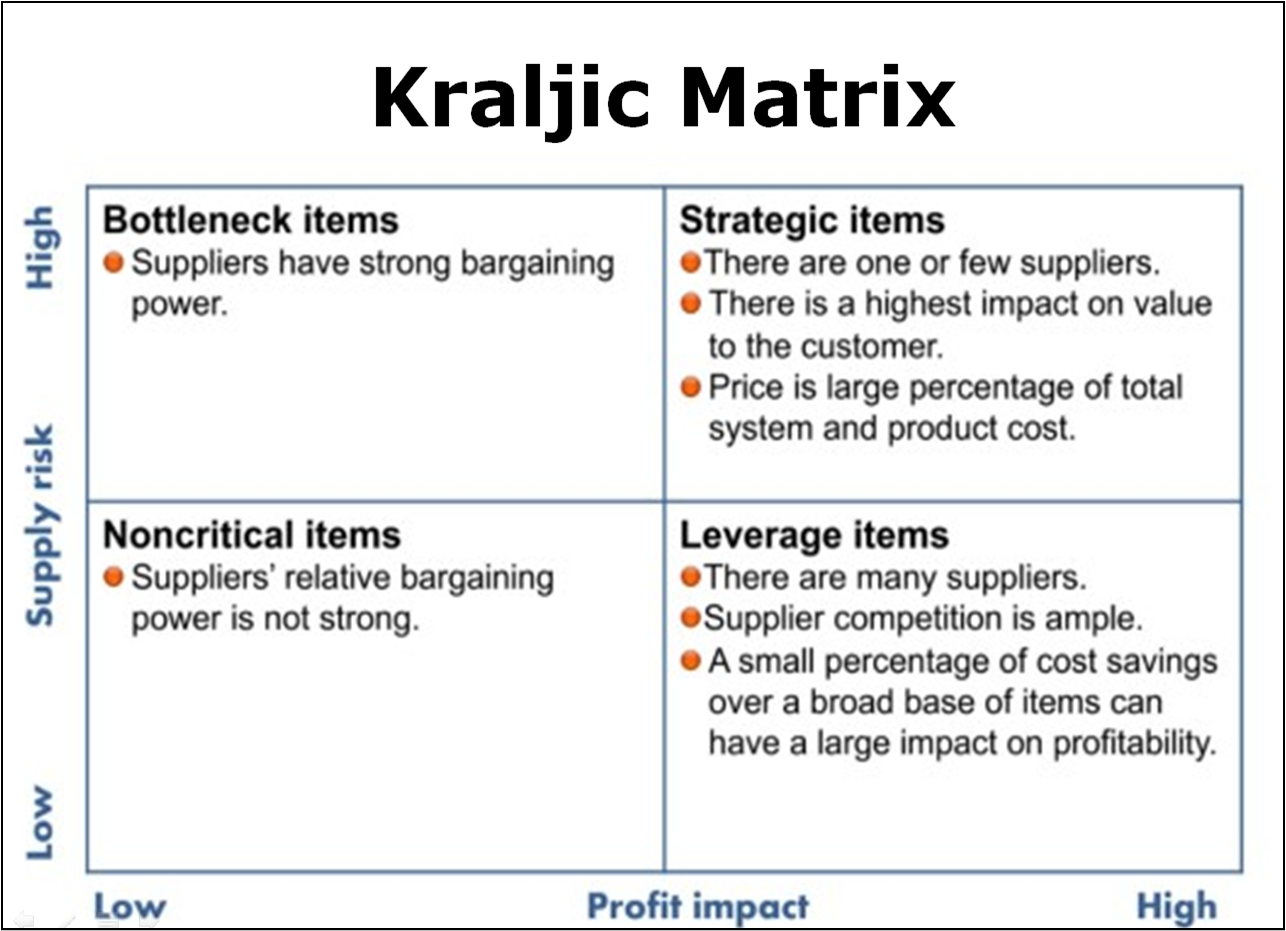
Quadrant 1 (Bottom Right) – Leverage!
The first quadrant is the low risk and high value box, it is named Leverage. Leverage quadrant represents purchases with high impact on profit, limited supply constraints, and with generally standard specifications.
Use the Following Strategies in Leverage Quadrant:
- Use purchasing power,
- Drive profit,
- Take calculated risks,
- Assess regularly the supply market capacity, and
- Push for price reductions.
Quadrant 2 (Top Right) – Strategic!
The second quadrant is the high supply risk and the high value box and is named Strategic.
Strategic quadrant represents key purchases with high impact on profit, critical availability, supply constraints, and complex specifications.
Use the Following Strategies in the Strategic Quadrant:
- Get access to supplier's technology and expertise,
- Initiate joint development,
- Create unique specifications,
- Align buyer and supplier business strategies,
- Work towards product differentiation to ensure competitive edge,
- Put medium and long term contracts in place.
Watch the scenario-based e-learning below for examples in the Strategic and Leverage Quadrants.
Step 4 – Supplier Relationship Analysis!
In the first 3 steps, we have assessed the needs based on the requirements and we analyzed the market and classified the item. Plus, we used the portfolio or Kraljic matrix, which indicates the relationship type to be engaged with the supplier.
However, the behavior and attitude of the suppliers has not yet been taken into account. The fourth step of the sourcing process, supplier relationship analysis, helps you as a buyer to determine which type of relationship can best fit the requirements.
It is important to understand why suppliers of items positioned in the same quadrant can behave differently towards their customer. Buyers should investigate how suppliers perceive their customer.
For example, do they view you (buyer) as a strategic partner with whom they can develop more business in the future or as a small unimportant customer?
The method to analyze this relationship is called supplier preference analysis, and is used by buyers to investigate how suppliers perceive their customer.
Essentially, this is the reverse of step 3.
In step 3 you analyzed how you view your supplier, not it is the time to determine how supplier sees you!
Using this method will help to understand the mutual relationship, and enable management of that relationship.
Watch the scenario-based e-learning below to briefly describe supplier relationship analysis.
Step 5 – Risk Management!
Generally, you can define risk as the uncertainty of an outcome. You have to anticipate whether the results of these events are of high or of low importance
As a buyer, you should have an in-depth view on the risk with a view to to minimize them, or eliminate them.
Risk management includes all activities require to identify, assess, and control the risks. It is an ongoing process as risks change constantly. Risk management should be in place to deal quickly and effectively with risks whenever they arise.
One of the most important risks you could face is the unavailability of materials you buy.
For example, during 2011 Kobe Earthquake many Japanese suppliers could not deliver, so having alternative sources of suppliers is a necessity.
But then, even with the best risk plans in place things can and will happen.
Ten years after the Kobe Earthquake, in 2021 because of the Covid-19 virus, the semiconductor and chips industry faces severe shortages and price was not as important as availability, resulting in higher prices and bottle-necks in the supply chain.
So, when it comes to risk - plan, have back up plans in place and then review those plans as and when the circumstances change.
Step 6 – Negotiation & Supplier Selection!
In step 6, we start with a four-step process.
- The first step is the definition of the supply strategy and creation of the award criteria.
- The second step is the creation of the RFP document.
- The third step is running the RFP, and finally,
- The fourth step is negotiation and award.
When negotiating, it is a best procurement practice to always negotiate the initial quotes offered by suppliers. It’s important to remember that a quote is not a concrete number but a price level at which the seller would like to do business.
It is just the starting point of most negotiations and a number that the seller feels can be supported at the start. A quote can be and usually is changed before an order is placed.
Further, negotiation is not just about price but for many more issues like those below.
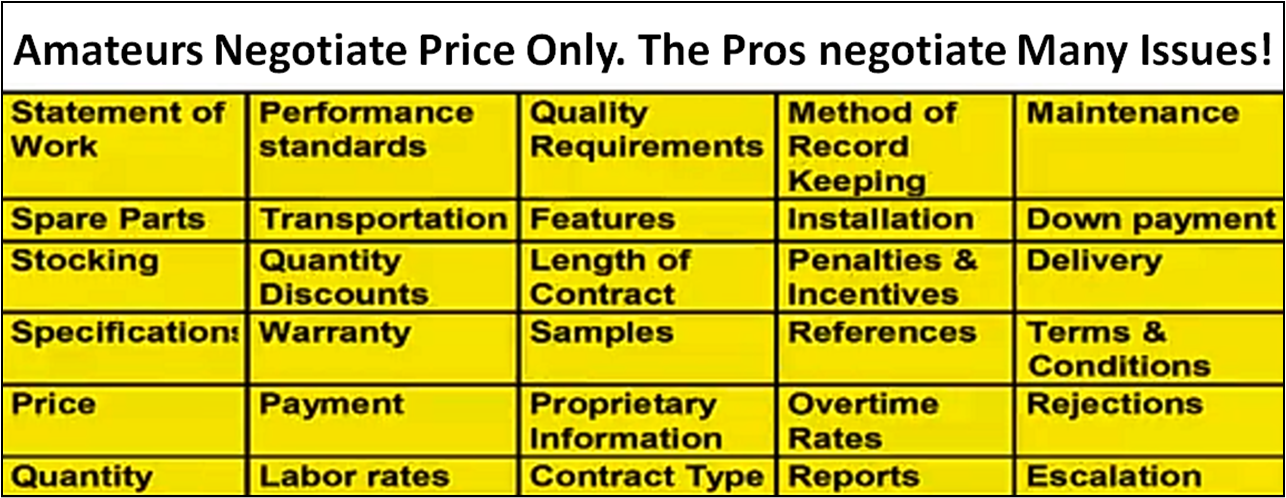
And now, for a good treat watch the Scenario-Based E-Learning below, which shows How to Bargain - the 1 Question that You should NEVER ask and what questions you should ask when negotiating!
Understand all the 4 Steps of the Negotiations Process with Real-Life Examples, by Accessing for Free the ...
7 Best Procurement Practices Free E-Course!
Negotiations Process is Best Practice No.4, including other practices like Fraud, Supplier Relationship Management, Category Management, Cost & Price Analysis and more.
This is a Real-Life & Practical E-Course for New & Seasoned Buyers - Retail Price $97 But Free for a Limited Time!
The goal in step 6 is to award the business to the supplier that can best achieve the objectives as defined by the supply strategy and the award criteria.
Step 7 – Continuous Improvement!
This is a key element of the strategic sourcing management process. It is the start of a continuous cycle, as illustrated at the beginning of the whole upstream and downstream process.
Once both upstream and downstream processes are completed, it’s back to Step 1 to determine needs, review the supply market again and restart the process in a constantly evolving marketplace.
Continue your strategic sourcing process journey by Getting a Head-Start in Building Next-Level Procurement Skills to Becoming a Confident, Respected & Recognized Procurement Pro with the ...
7 Best Procurement Practices Free E-Course!
Real-Life & Practical E-Course for New & Seasoned Buyers - Retail Price $97 But Free for a Limited Time!
Get Your Multi Phase Strategic Sourcing Process BluePrint that Shows Key Phases & Deliverables for Ease of Reference.
Want the "How" rather than “Why” or “What” of Strategic Sourcing Process? Download the "Strategic Sourcing Report" & find out How to develop formal sourcing plans with a detailed outline of what typically would be in such a plan.
3 Days Expert Strategic Sourcing Course
With Case Studies & Real Life Scenarios! For those who are familiar with strategic sourcing but looking to get at the top of their game.
Return from Strategic sourcing process to Definition of Sourcing
Return from Strategic sourcing process to Purchasing Procurement Center Homepage
*Source: 2001 A.T. Kearney

